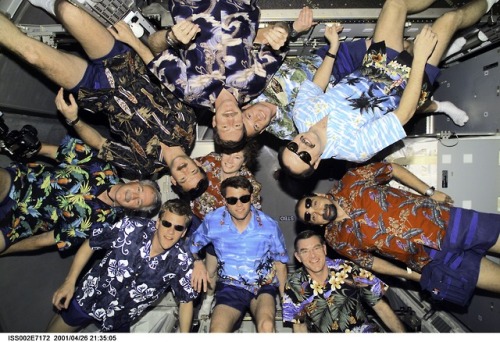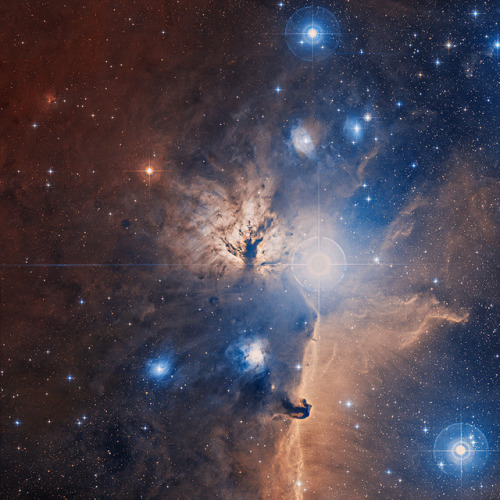Mount Wilson Observatory, The Pleiades, M45, +/- 1950 United States.

Mount Wilson Observatory, The Pleiades, M45, +/- 1950 United States.
Vintage silver print
More Posts from Space-cute and Others

3 … 2 … 1… ALOHA!
Sometimes in space, you have to set your clocks to island time and gather for a good Hawaiian shirt day. In this 2001 #TBT, Expedition Two and STS-100 crew members gather for a group photo with a pre-set digital still camera.
Clockwise from the 12 o'clock point in the circle are Kent V. Rominger, Yuri V. Lonchakov, Yury V. Usachev, Umberto Guidoni, James S. Voss, Jeffrey S. Ashby, Scott E. Parazynski, John L. Phillips and Chris A. Hadfield, with Susan J. Helms at center. Usachev, Helms and Voss are members of three Expedition Two crew, with the other seven serving as the STS-100 crew on the Space Shuttle Endeavour. Usachev and Lonchakov represent Rosaviakosmos; Guidoni is associated with the European Space Agency (ESA); and Hadfield is from the Canadian Space Agency (CSA).
Make sure to follow us on Tumblr for your regular dose of space: http://nasa.tumblr.com.

A galactic mega-merger

Lake Blanche, Utah by jswervedizzle
★☆★ SPACE ★☆★

Scott and Mark Kelly are identical twin brothers — at least, they were until Scott spent a year living in space.
When Scott Kelly returned to Earth after a 340-day voyage aboard the International Space Station (ISS) two years ago, he was 2 inches taller than he’d been when he left. His body mass had decreased, his gut bacteria were completely different, and — according to preliminary findings from NASA researchers — his genetic code had changed significantly. (Interestingly, Scott Kelly has since shrunk back down to his initial prespaceflight height.)
A new NASA statement suggests the physical and mental stresses of Scott Kelly’s year in orbit may have activated hundreds of “space genes” that altered the astronaut’s immune system, bone formation, eyesight and other bodily processes. While most of these genetic changes reverted to normal following Scott Kelly’s return to Earth, about 7 percent of the astronaut’s genetic code remained altered — and it may stay that way permanently.

Ojos del Salar, Atacama Desert
sorry what



-
 dirawong liked this · 2 months ago
dirawong liked this · 2 months ago -
 oldfrankland liked this · 2 months ago
oldfrankland liked this · 2 months ago -
 brutal-e reblogged this · 3 months ago
brutal-e reblogged this · 3 months ago -
 4rt44rtsake reblogged this · 3 months ago
4rt44rtsake reblogged this · 3 months ago -
 shabbyvictorianslumbers liked this · 3 months ago
shabbyvictorianslumbers liked this · 3 months ago -
 otipemisiwak liked this · 4 months ago
otipemisiwak liked this · 4 months ago -
 thedepressedpelican liked this · 4 months ago
thedepressedpelican liked this · 4 months ago -
 maylilithreign liked this · 4 months ago
maylilithreign liked this · 4 months ago -
 poisonveins reblogged this · 4 months ago
poisonveins reblogged this · 4 months ago -
 poisonveins liked this · 4 months ago
poisonveins liked this · 4 months ago -
 faerytaledvwn reblogged this · 4 months ago
faerytaledvwn reblogged this · 4 months ago -
 unameden liked this · 4 months ago
unameden liked this · 4 months ago -
 thesilverwalrus liked this · 4 months ago
thesilverwalrus liked this · 4 months ago -
 angria reblogged this · 4 months ago
angria reblogged this · 4 months ago -
 nyxeraphim liked this · 4 months ago
nyxeraphim liked this · 4 months ago -
 foxinthelibrary liked this · 4 months ago
foxinthelibrary liked this · 4 months ago -
 glowingdreams liked this · 4 months ago
glowingdreams liked this · 4 months ago -
 mary-shelley-1816 reblogged this · 4 months ago
mary-shelley-1816 reblogged this · 4 months ago -
 rizno liked this · 4 months ago
rizno liked this · 4 months ago -
 allowmetowallow reblogged this · 4 months ago
allowmetowallow reblogged this · 4 months ago -
 allowmetowallow liked this · 4 months ago
allowmetowallow liked this · 4 months ago -
 harmony3s liked this · 4 months ago
harmony3s liked this · 4 months ago -
 velumnoctis reblogged this · 4 months ago
velumnoctis reblogged this · 4 months ago -
 wanderer001 reblogged this · 5 months ago
wanderer001 reblogged this · 5 months ago -
 wanderer001 liked this · 5 months ago
wanderer001 liked this · 5 months ago -
 celticwarriorcj reblogged this · 5 months ago
celticwarriorcj reblogged this · 5 months ago -
 shannybangbang reblogged this · 5 months ago
shannybangbang reblogged this · 5 months ago -
 peachiesmile reblogged this · 5 months ago
peachiesmile reblogged this · 5 months ago -
 bwiser2 liked this · 5 months ago
bwiser2 liked this · 5 months ago -
 dew-ontherocks liked this · 5 months ago
dew-ontherocks liked this · 5 months ago -
 divine-nonchalance liked this · 5 months ago
divine-nonchalance liked this · 5 months ago -
 divine-nonchalance reblogged this · 5 months ago
divine-nonchalance reblogged this · 5 months ago -
 iszisdemure liked this · 5 months ago
iszisdemure liked this · 5 months ago -
 mouth-of-life reblogged this · 5 months ago
mouth-of-life reblogged this · 5 months ago -
 exquisitius reblogged this · 5 months ago
exquisitius reblogged this · 5 months ago -
 heavenlysuicide reblogged this · 5 months ago
heavenlysuicide reblogged this · 5 months ago -
 jasonlowder liked this · 5 months ago
jasonlowder liked this · 5 months ago -
 missingyouinchains liked this · 5 months ago
missingyouinchains liked this · 5 months ago -
 shannybangbang reblogged this · 5 months ago
shannybangbang reblogged this · 5 months ago -
 catpissbongwater liked this · 5 months ago
catpissbongwater liked this · 5 months ago -
 merifera reblogged this · 5 months ago
merifera reblogged this · 5 months ago -
 merifera liked this · 5 months ago
merifera liked this · 5 months ago -
 beshenyy liked this · 5 months ago
beshenyy liked this · 5 months ago -
 carmillavalentine reblogged this · 5 months ago
carmillavalentine reblogged this · 5 months ago -
 carmillavalentine liked this · 5 months ago
carmillavalentine liked this · 5 months ago -
 ghostlypetal reblogged this · 5 months ago
ghostlypetal reblogged this · 5 months ago -
 smile-at-the-void liked this · 5 months ago
smile-at-the-void liked this · 5 months ago


